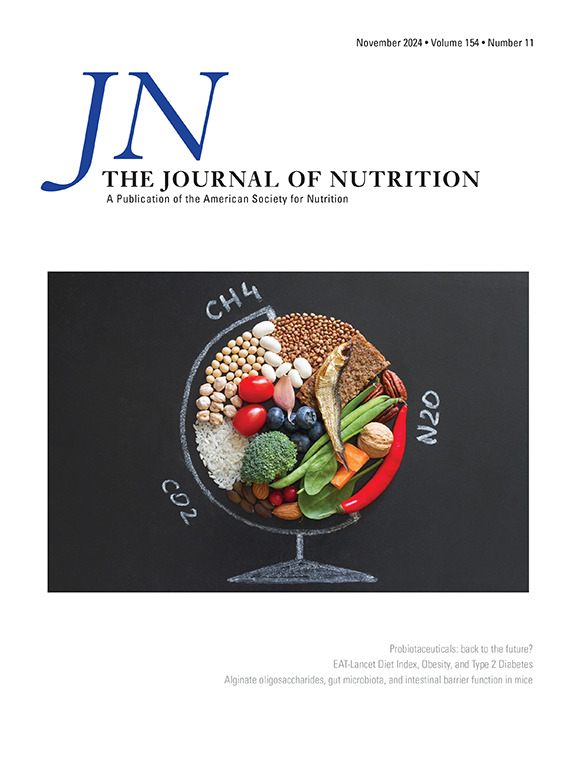EAT-Lancet 饮食指数与多种族队列中较低的肥胖率和 2 型糖尿病发病率有关。
IF 3.7
3区 医学
Q2 NUTRITION & DIETETICS
引用次数: 0
摘要
背景:EAT-Lancet委员会制定了名为EAT-Lancet饮食的膳食建议,以促进全球健康营养和可持续食品生产:我们为多民族队列(MEC)研究的参与者制定了 EAT-Lancet 饮食的适应性评分,并分析了其与肥胖和 2 型糖尿病(T2D)发病率的关系:方法:多民族队列研究包括自 1993-96 年以来跟踪调查的 5 个民族。方法:MEC 包括自 1993-96 年以来跟踪调查的 5 个种族群体,通过问卷调查评估了入组(Qx1)和 10 年后(Qx3)的人体测量特征和饮食摄入量。为了创建 EAT-Lancet 指数(范围:0-48 分),对 16 个食物组采用了 3 分制评分,标准化为 2,500 千卡/天。通过重复自我报告和管理数据确定了 T2D 病例。在一项前瞻性设计中,采用 Cox 回归评估了 Qx3 阶段的肥胖和 T2D 发病率,以估算危险比 (HR) 和 95% 置信区间 (95%CI),同时调整了相关协变量:在 193 379 名 MEC 参与者中,EAT-Lancet 指数的总平均值为 25±4 分,发现了 46 140 个新的 T2D 病例。女性、日裔美国人和夏威夷原住民以及健康体重者的调整后平均值高于超重或肥胖者。在 EAT-Lancet 分数较高的队列成员中,肥胖率较低(HR 0.76;95%CI 0.73,3 级与 1 级相比为 0.79)。虽然EAT-Lancet指数最高(27-42分)与最低(9-23分)三等分参与者的T2D发病率低10%(HR 0.90;95%CI 0.88,0.92),但经过体重指数调整后,这种关联性有所减弱(HR 0.97;95%CI 0.94,0.99)。这种与 T2D 的负相关仅限于非洲裔美国人和欧洲裔美国人:这些研究结果支持这样的假设,即坚持 EAT-Lancet 饮食与较低的肥胖风险有关,这可能是 T2D 发病率略有下降的部分原因。本文章由计算机程序翻译,如有差异,请以英文原文为准。
The EAT-Lancet Diet Index Is Associated with Lower Obesity and Incidence of Type 2 Diabetes in the Multiethnic Cohort
Background
The EAT-Lancet Commission has developed dietary recommendations, named the EAT-Lancet diet, to promote healthy nutrition and sustainable food production worldwide.
Objectives
We developed an adapted score for the EAT-Lancet diet for participants of the Multiethnic Cohort (MEC) Study and its relation with incidence of obesity and type 2 diabetes (T2D).
Methods
The MEC includes 5 ethnic groups followed since 1993–1996. Anthropometric characteristics and dietary intake were assessed by questionnaire at cohort entry (Qx1) and 10 y later (Qx3). To create the EAT-Lancet index (range: 0–48 points), a 3-point scoring system for 16 food groups standardized to 2500 kcal/d was applied. T2D cases were identified through repeated self-reports and administrative data. In a prospective design, obesity at Qx3 and T2D incidence were evaluated using Cox regression to estimate hazard ratios (HR) with 95% confidence intervals (95% CI) while adjusting for relevant covariates.
Results
Among 193,379 MEC participants, the overall mean of the EAT-Lancet index score was 25 ± 4 points and 46,140 new T2D cases were identified. Higher adjusted means were observed in females than males, in participants of Japanese American and Native Hawaiian ancestry, and in those with healthy weight than overweight or obese. Obesity was lower in cohort members with higher EAT-Lancet scores (HR: 0.76; 95% CI: 0.73, 0.79 for tertile 3 compared with 1). Although T2D incidence was 10% lower among participants in the highest (27–42 points) compared with the lowest (9–23 points) EAT-Lancet index tertile (HR: 0.90; 95% CI: 0.88, 0.92), the association was attenuated after BMI adjustment (HR: 0.97; 95% CI: 0.94, 0.99). This inverse association with T2D was restricted to African American and European American participants.
Conclusions
These findings support the hypothesis that adherence to the EAT-Lancet diet is related to a lower risk of obesity, which may be partially responsible for the small reduction in T2D incidence.
求助全文
通过发布文献求助,成功后即可免费获取论文全文。
去求助
来源期刊

Journal of Nutrition
医学-营养学
CiteScore
7.60
自引率
4.80%
发文量
260
审稿时长
39 days
期刊介绍:
The Journal of Nutrition (JN/J Nutr) publishes peer-reviewed original research papers covering all aspects of experimental nutrition in humans and other animal species; special articles such as reviews and biographies of prominent nutrition scientists; and issues, opinions, and commentaries on controversial issues in nutrition. Supplements are frequently published to provide extended discussion of topics of special interest.
 求助内容:
求助内容: 应助结果提醒方式:
应助结果提醒方式:


